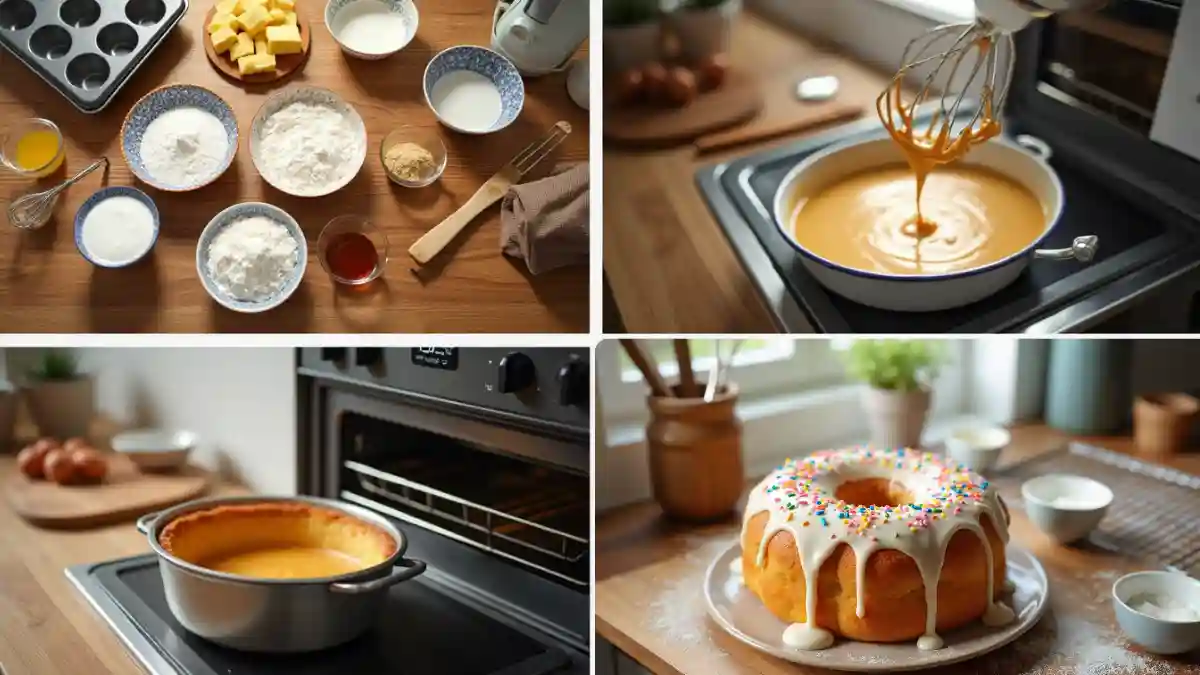A donut cake perfectly combines the flavors of a classic donut with the soft, tender crumb of a well-baked cake. This unique dessert is ideal for celebrations or a cozy weekend treat. By following this guide, you’ll master the art of baking a delicious donut cake recipe that’s sure to impress.
Table of Contents
What Is a Donut Cake?
A donut cake is essentially a baked cake that replicates the nostalgic flavor and texture of a traditional donut. It’s a healthier alternative to fried donuts, offering all the flavors without the extra grease. The inclusion of nutmeg is key, giving the cake its distinctive donut essence.
If you’re looking for more inspiration for cakes with standout flavors, check out the guide on the most delicious cake in the world.
Why Choose a Donut Cake?
Baking a donut cake offers unique benefits:
- Healthier Option: Unlike fried donuts, this cake is baked, making it less greasy and lower in calories.
- Customizable: You can experiment with various flavors, toppings, and fillings.
- Perfect for Celebrations: It’s a versatile choice for birthdays or casual gatherings.
Wondering how this cake compares to other birthday favorites? Learn more about choosing the best cake for birthdays.
Ingredients for Donut Cake
Creating the perfect donut cake recipe starts with the right balance of ingredients. Here’s a more detailed look at the ingredients and their importance:
Dry Ingredients
- All-Purpose Flour (2 ½ cups)
The backbone of your cake, flour provides structure. For a lighter texture, consider sifting the flour to eliminate lumps.- Alternative: Use a gluten-free baking mix for a gluten-free version.
- Baking Powder and Baking Soda.
These leavening agents ensure the cake rises properly, resulting in a soft, airy crumb.- Tip: Check the freshness of your baking powder and soda before use.
- Ground Nutmeg (1 teaspoon)
A signature flavor in donut cakes, nutmeg adds warmth and depth, evoking the classic taste of a traditional donut.- Variation: Swap or complement with cinnamon for a spiced version.
- Salt (¼ teaspoon)
Enhances the other flavors and balances the sweetness.
Wet Ingredients
- Unsalted Butter (1 cup, softened)
Provides richness and moisture. Creaming butter with sugar traps air, contributing to the cake’s fluffy texture.- Alternative: Substitute with vegan butter for a dairy-free option.
- Granulated Sugar (1 ½ cups)
Sweetens the cake and contributes to its golden color during baking.- Optional: Use brown sugar for a slightly deeper, caramel-like flavor.
- Eggs (3 large)
Bind the ingredients together and provide structure. The eggs also contribute to the moistness and richness of the cake.- Egg Substitute: Use 3 tablespoons of flaxseed meal mixed with 9 tablespoons of water for a vegan-friendly cake.
- Sour Cream or Plain Yogurt (1 cup)
Adds tanginess and ensures the cake remains moist and tender.- Alternative: Use Greek yogurt for a thicker consistency or buttermilk for a slightly looser batter.
- Vanilla Extract (2 teaspoons)
Enhances the flavor profile, adding a sweet, aromatic undertone.- Pro Tip: Use pure vanilla extract for the best results.
Optional Flavor Enhancers
- Lemon Zest (1 teaspoon)
Adds a refreshing citrus note, especially great for spring or summer variations. - Cinnamon (½ teaspoon)
Complements the nutmeg for a warm, spiced flavor. - Cocoa Powder (3 tablespoons)
For a chocolate version, add cocoa powder and increase the sugar slightly to balance the bitterness.
Glaze Ingredients
- Powdered Sugar (1 ½ cups)
The base of your glaze, powdered sugar creates a smooth, sweet topping. - Milk (2-3 tablespoons)
Adjust the quantity to achieve the desired glaze consistency. - Vanilla Extract (½ teaspoon)
Adds a hint of flavor to the glaze.- Variation: Add almond extract for a nutty twist.
By understanding the role of each ingredient, you can tweak the recipe to suit your preferences or dietary needs while ensuring a delectable donut cake.
Essential Baking Tools
For a smooth baking process, you’ll need:
- A Bundt pan (non-stick recommended)
- Whisk or stand mixer
- Cooling rack
- Parchment paper (for lining)
For those exploring general cake-baking techniques, our guide on how to bake a cake step-by-step is a helpful resource.
Step-by-Step Donut Cake Recipe
Baking a donut cake is a straightforward process, but attention to detail ensures the best results. Follow these detailed steps to master the recipe:
1: Preheat and Prepare
- Preheat the Oven
Set your oven to 350°F (175°C). Proper preheating ensures even baking, allowing the cake to rise consistently. - Prepare the Pan
- Grease a Bundt pan thoroughly with butter or non-stick spray, ensuring all crevices are coated.
- Pro Tip: Use parchment paper for a loaf or round pan if you’re not using a Bundt pan.
2: Mix the Dry Ingredients
- In a medium bowl, combine:
- 2 ½ cups of all-purpose flour
- 1 teaspoon baking powder
- ½ teaspoon baking soda
- 1 teaspoon ground nutmeg
- ¼ teaspoon salt
- Whisk together to evenly distribute the leavening agents and spices. This step prevents clumps and ensures a uniform batter.
3: Cream the Wet Ingredients
- Cream Butter and Sugar
Use a hand or stand mixer to beat:- 1 cup unsalted butter (softened)
- 1 ½ cups granulated sugar
Beat on medium speed until the mixture is pale and fluffy, about 3–5 minutes. This process incorporates air, crucial for a light texture. - Tip: Scrape down the sides of the bowl regularly to ensure even mixing.
- Add Eggs
Add 3 eggs in one time, beating well after each addition. This helps the batter emulsify, preventing it from splitting. - Incorporate Vanilla Extract
Mix in 2 teaspoons of vanilla extract for an aromatic base flavor.
4: Combine Wet and Dry Ingredients
- Alternate Additions
- 1 cup sour cream or plain yogurt.
Start and end with the dry ingredients.
- 1 cup sour cream or plain yogurt.
- Final Consistency
The batter should be thick but smooth, with no lumps.
5: Bake the Cake
- Bake
Place the pan in the center of the oven and bake for 40–50 minutes.- Begin checking for doneness at the 40-minute mark by inserting a toothpick into the center. If it comes out clean, the cake is ready.
- Pro Tip: Avoid opening the oven door early, as this can cause the cake to sink.
- Cool the Cake
Remove the cake from the oven for 15 min. This allows the structure to set, making it easier to release.- Carefully invert the cake onto a wire rack and let it cool completely before glazing.
6: Prepare the Glaze
- In a medium bowl, whisk together:
- 1 ½ cups powdered sugar
- 2–3 tablespoons milk (adjust for desired consistency)
- ½ teaspoon vanilla extract
- Optional: Add a pinch of nutmeg or cinnamon for extra flavor.
- The glaze should be smooth and pourable but thick enough to coat the back of a spoon.
7: Glaze the Cake
- Place the cooled cake on a wire rack set over a baking sheet to catch excess glaze.
- Slowly drizzle the glaze over the top, letting it flow naturally down the sides.
- Optional Decorations:
- Add sprinkles, powdered sugar, or chopped nuts before the glaze sets.
8: Serve and Enjoy
- Slice the cake and serve as is or with a side of whipped cream, fresh fruit, or ice cream.
- Storage Tip: Wrap leftovers tightly in plastic wrap and store at room temperature for up to three days.
By breaking the recipe into these detailed steps, you can confidently create a perfectly moist, flavorful donut cake every time!
Variations to Try
Experiment with these popular twists:
- Apple Cider Donut Cake: Replace sour cream with apple cider and add cinnamon.
- Chocolate Glazed Donut Cake: Top with rich chocolate ganache.
- Lemon Poppy Seed Donut Cake: Add poppy seeds and lemon zest for a refreshing flavor.
Decorating Your Donut Cake
Decorating a donut cake is an opportunity to elevate its visual appeal and add flavor enhancements. Whether you’re preparing it for a celebration or personal enjoyment, the right decorations can make your cake irresistible. Here’s a detailed guide to decorating your donut cake like a pro:
1. Glazing for a Classic Look
The glaze is the quintessential topping for a donut cake. Its smooth texture adds a glossy finish and locks in moisture.
- Basic Glaze Recipe:
- 1 ½ cups powdered sugar
- 2–3 tablespoons milk
- ½ teaspoon vanilla extract
- Tips for Application:
- Use a spoon or ladle to drizzle the glaze over the cake evenly.
- For a layered effect, let the first glaze coat set before adding a second drizzle.
- Flavor Variations:
- Add a splash of lemon juice for a citrus glaze.
- Mix in cocoa powder for a chocolate glaze.
- Incorporate maple syrup for a rich, earthy flavor.
2. Add Toppings for Texture
Toppings not only enhance the presentation but also add a delightful crunch or flavor contrast.
- Sprinkles:
- Use rainbow or monochromatic sprinkles for a fun, festive look.
- Apply them immediately after glazing to ensure they stick.
- Powdered Sugar or Cinnamon Sugar:
- Dust the cooled cake lightly for a simple yet elegant finish.
- Shredded Coconut:
- Sprinkle toasted or plain coconut for a tropical twist.
- Candied Fruit or Zest:
- Decorate with candied orange slices, lemon zest, or cherries for a vibrant pop of color.
3. Frosting for a Bold Statement
If you’re looking for a richer finish, frosting is an excellent option.
- Buttercream Frosting:
- Pipe buttercream around the edges or create decorative swirls.
- Cream Cheese Frosting:
- Spread cream cheese frosting over the top for a tangy contrast.
- Ganache Drizzle:
- Pour a warm chocolate ganache over the cake for a luxurious, glossy finish.
4. Themed Decorations
Perfect for special occasions, themed decorations can make your donut cake the centerpiece of any event.
- Birthdays:
- Add edible glitter, candles, or custom cake toppers.
- Holidays:
- Use seasonal sprinkles (e.g., red and green for Christmas, pastels for Easter).
- Celebrations:
- Incorporate fondant decorations or colored icing for a personalized touch.
5. Advanced Techniques
For those who want to go the extra mile, here are some advanced ideas:
- Drip Effect:
- Use a thicker glaze or ganache to create a drip effect around the edges.
- Layered Glaze:
- Divide the glaze into portions and add food coloring for a rainbow or ombre effect.
- Edible Flowers:
- Decorate with fresh or candied edible flowers like pansies, violets, or lavender for an elegant finish.
6. Serve with a Twist
Consider pairing the cake with additional elements for a show-stopping presentation:
- Side Sauces:
- Serve with caramel, chocolate sauce, or berry compote.
- Decorative Plating:
- Dust the plate with cocoa powder or powdered sugar before placing the cake slice.
Final Tips for Decorating Success
- Always allow the cake to cool completely before decorating to prevent melting or slipping.
- Plan your decorations ahead of time to match the occasion or theme.
- Less is more—focus on one or two elements to avoid overloading the design.
Decorating your donut cake not only enhances its beauty but also makes it uniquely yours. With these ideas, your cake will be as delightful to look at as it is to eat!
Frequently Asked Questions
Q: How do I store a donut cake?
A: Store it in an airtight container at room temperature for up to three days.
Q: What’s the secret to a moist donut cake?
A: Using sour cream or yogurt ensures a tender and moist crumb.
Why This Recipe Stands Out
This recipe delivers a perfect balance of flavor, texture, and customization options. Whether you’re a beginner or a pro, the donut cake recipe is a must-try addition to your dessert repertoire.
Pair it with other unique desserts by exploring our guide on Asian-inspired sweet treats.

